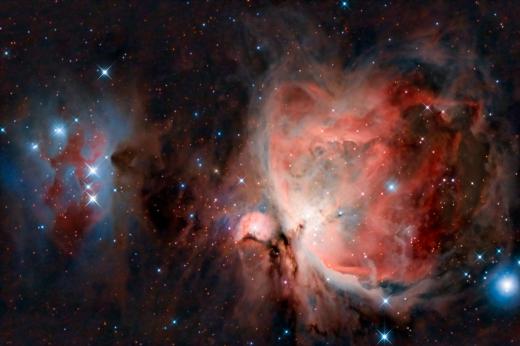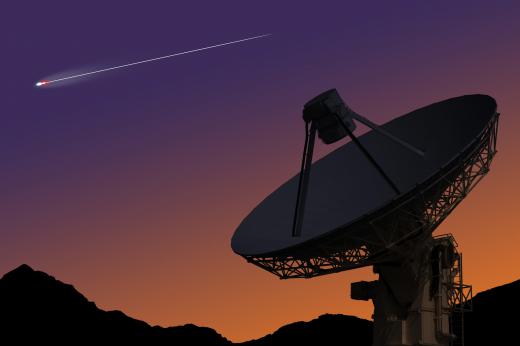What Is the Solar Nebula?
It is thought that our solar system formed about 4.6 billion years ago from a large cloud of gas and dust, measuring several light years in diameter, known as a nebula. This cloud consisted mainly of hydrogen gas, with smaller amounts of the elements which make up the solar system today. According to the solar nebula theory, part of this cloud began to contract gravitationally, possibly due to disturbance by a nearby supernova or the passage of another star, and as it did so the initial slow rotation of the cloud began to increase as it contracted, causing it to flatten out into a disk shape. As more material accumulated in the center of the disk, the density and temperature increased, reaching the point where fusion of hydrogen atoms started, forming helium and releasing huge amounts of energy, resulting in the birth of the Sun. The planets, asteroids and comets formed from the leftover material.
After a time, further collapse was halted by the Sun reaching hydrostatic equilibrium. The solar wind from the young Sun dispersed a large part of the material in the solar nebula, reducing its density, and the nebula began to cool. Aside from the three lightest elements — hydrogen, helium and lithium — the elements of which the solar nebula was composed were either formed by nuclear fusion in stars now long gone or, in the case of elements heavier than iron, created by supernovae. Simple covalent molecules, including water, methane and ammonia, and ionic molecules, such as metal oxides and silicates, would also have been present. Initially, due to the high temperatures in the disk, these compounds would have been gaseous, but as cooling took place most of the elements and compounds condensed into tiny particles; the metals and ionic compounds condensed first due to their higher boiling and melting points.

Near the center of the disk, metals, metal compounds and silicates predominated, but further out, where temperatures were lower, large amounts of ice condensed out of the nebula. In this outer region gaseous hydrogen and helium were also plentiful; these gases were largely dispersed by the solar wind closer to the Sun. Tiny solid particles collided and stuck together, forming ever larger objects which began to attract more material through gravitation, eventually resulting in the formation of planets. In the inner solar system, the lack of ice, hydrogen and helium resulted in the formation the relatively small planets Mercury, Venus, Earth and Mars, composed largely of rock. Farther out, ice as well as mineral particles aggregated, forming larger bodies that were able to retain the light gases hydrogen and helium through their relatively strong gravitational fields, resulting in the “gas giant” planets, Jupiter, Saturn, Uranus and Neptune.

The solar nebula theory accounts for a number of key features of our solar system. The fact that the planets — with the exception of Pluto, which is no longer considered a planet — all lie in more or less the same plane, and the fact that they all orbit the Sun in the same direction suggest that they originated in a disk surrounding the Sun. The presence of relatively small, rocky planets in the inner solar system and gas giants in the outer region also fits well with this model.
Beyond Neptune, the outermost planet, lies the Kuiper Belt, a region of relatively small objects composed of rock and ice. It is thought that Pluto might have originated here, and that comets are Kuiper Belt objects that have been nudged into orbits that bring them into the inner solar system. The Kuiper Belt is also well explained by the solar nebula theory as resulting from leftover ice and rocky material too thinly dispersed to have formed planets.
Further evidence supporting this theory comes from elsewhere in the Milky Way. Astronomers can study parts of our galaxy where stars are currently forming, such as the Orion Nebula, a large volume of gas located in the constellation of Orion. Most of the new stars in this nebula are surrounded by disks of gas and dust from which it is thought that planets will eventually form.
AS FEATURED ON:
AS FEATURED ON:












Discuss this Article
Post your comments